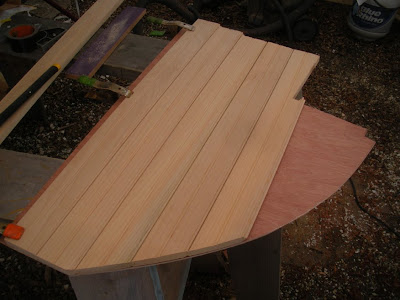Once fair, I was able to bend in two oak cleats along the inside top edge that the deck beams with notch into. I had just enough White Oak from last winter to saw out my 5 deck beams 3/4" x 1 1/8", a little bigger then specified. Once these were cut and the undersides routed over with an 1/8" bit, I started fitting them to the notches in the cleats. As each one fit in, I was able to get a good idea of how the cuddy would affect the overall feel of the boat, which I think is a huge improvement.
When these were all cut and fit, I mixed up a batch of G-Flex epoxy and screwed them in, allowing them to dry overnight. With these in, I was able to start tackling the bulkheads. Brad Pease suggested heading down to Wood Lumber Company in Falmouth, a great place for wood lovers, to check out their tongue and groove beaded Port Orford Cedar, which is lightweight, beautiful, and smells amazing. I picked up 10 boards 1"x4" x 7 feet long. Before I could fit the cedar in place, I needed to make a mold of the bulkhead so I could shape the cedar to the curve of the hull. I whipped up a little jig using scraps of plywood, pointer sticks that I made, and hot glue to hold it all together. I picked up all the angles I needed and laid it all out on some plywood. With a little shaping, it fit nicely in place. I was then able to locate where my cleats needed to be, and installed those. Then, I removed the mold and laid the Cedar on top of it, cutting the pieces to shape. Once they were all cut, I then brought them into the boat for final fitting and screwed them into the cleats. By the end of the day Sunday, I had the STBD bulkhead fit and screwed in. It still needs to be shaped and faired at the top where it attaches to the deck beam, then completely removed and bedded and glued down.


































